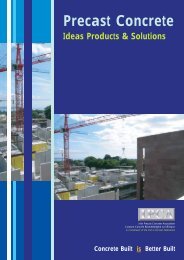Concrete Today May 2010 - the Irish Concrete Federation
Concrete Today May 2010 - the Irish Concrete Federation
Concrete Today May 2010 - the Irish Concrete Federation
You also want an ePaper? Increase the reach of your titles
YUMPU automatically turns print PDFs into web optimized ePapers that Google loves.
concrete today - techrete - olympic village, london 2012<br />
Precast Cladding Panels by Techrete Ltd.<br />
Ireland’s leading Precast concrete panel<br />
manufacturer, Techrete Ltd., is currently<br />
involved in <strong>the</strong> construction of apartment<br />
buildings in London’s Olympic village. The<br />
village will house <strong>the</strong> Olympic athletes for<br />
<strong>the</strong> 2012 Olympics and will comprise a<br />
series of mansion blocks, each containing<br />
6 to 7 buildings, arranged in courtyard<br />
formation and varying in height from eight<br />
to twelve stories. Techrete were chosen as<br />
<strong>the</strong> Precast panel manufacturers, for four<br />
mansion blocks primarily on <strong>the</strong> basis that<br />
<strong>the</strong> company could demonstrate <strong>the</strong> ability<br />
to deal with <strong>the</strong> challenges posed by <strong>the</strong><br />
project, in particular its complexity and tight<br />
programme and logistics.<br />
The project posed a fur<strong>the</strong>r unusual<br />
challenge, in that <strong>the</strong> Architects specification<br />
required that two of <strong>the</strong> buildings should be<br />
clad in reconstructed stone panels, faced in<br />
frieze type images, replicated from 5 of <strong>the</strong><br />
famous Par<strong>the</strong>non Marbles (see text in side<br />
panel) <strong>the</strong> majority of which are currently<br />
housed in <strong>the</strong> British Museum. The<br />
architects selected <strong>the</strong>se images specifically<br />
to reflect <strong>the</strong> Greek origins and invoke <strong>the</strong><br />
ancient spirit of <strong>the</strong> Games.<br />
Replicating <strong>the</strong> images from <strong>the</strong><br />
Par<strong>the</strong>non Marbles posed a significant<br />
challenge which was eventually resolved by<br />
<strong>the</strong> use of scanning technology. The use of<br />
this technology negated <strong>the</strong> need for casts<br />
Precast Cladding Panels<br />
by Techrete Ltd.<br />
to be taken, which could potentially have<br />
caused damage to <strong>the</strong> marbles and <strong>the</strong>refore<br />
was not a viable option. The Scanning<br />
equipment produced 3-D image files which<br />
were <strong>the</strong>n transferred to a CNC (5 axis)<br />
routing machine to create a positive MDF<br />
(wooden) carved copy of <strong>the</strong> originals, from<br />
which rubber moulds were produced to<br />
cast <strong>the</strong> reconstructed stone panels. This<br />
was a complicated process which required<br />
approvals at all stages and a high degree of<br />
technical expertise.<br />
Precast Cladding Panels<br />
by Techrete Ltd.<br />
The architect’s specification required<br />
that <strong>the</strong> frieze images be replicated at three<br />
times <strong>the</strong> scale of <strong>the</strong> original marbles. The<br />
use of digital technology facilitated this<br />
aspect of <strong>the</strong> specification. Ano<strong>the</strong>r aspect<br />
of <strong>the</strong> reproduction is that all elements of<br />
<strong>the</strong> frieze images which could act as rain<br />
shelves were filled-in (in <strong>the</strong> construction of<br />
<strong>the</strong> mould). This however does not detract<br />
from <strong>the</strong> appearance, since <strong>the</strong> panels<br />
are generally viewed from <strong>the</strong> underside<br />
(looking upwards) and <strong>the</strong>refore <strong>the</strong> three<br />
dimensional appearance is retained.<br />
The use of frieze panels in modern<br />
buildings is rare and this is due in part to<br />
<strong>the</strong> influence of <strong>the</strong> modern movement in<br />
WHAT ARE THE<br />
PARTHENON MARBLES?<br />
When <strong>the</strong> Par<strong>the</strong>non was built between<br />
447BC and 432BC, three sets of<br />
sculptures, <strong>the</strong> metopes, <strong>the</strong> frieze and<br />
<strong>the</strong> pediments, were created to adorn it.<br />
Of <strong>the</strong>se, <strong>the</strong> metopes and <strong>the</strong> frieze were<br />
part of <strong>the</strong> structure of <strong>the</strong> Par<strong>the</strong>non<br />
itself. They were not carved first<br />
and <strong>the</strong>n put in place, high up on <strong>the</strong><br />
Par<strong>the</strong>non, but were carved on <strong>the</strong> sides<br />
of <strong>the</strong> Par<strong>the</strong>non itself after it had been<br />
constructed.<br />
The metopes were individual sculptures<br />
in high relief. There were 92 metopes, 32<br />
on each side and 14 at each end and each<br />
metope was separated from its neighbours<br />
by a simple architectural decoration called<br />
a triglyph. The metopes were placed<br />
around <strong>the</strong> building, above <strong>the</strong> outside<br />
row of columns and showed various<br />
mythical battles. The North side showed<br />
scenes from <strong>the</strong> Trojan war; <strong>the</strong> South<br />
side showed a battle between <strong>the</strong> Greeks<br />
and <strong>the</strong> Centaurs - part man, part horse;<br />
<strong>the</strong> East side showed <strong>the</strong> Olympian gods<br />
fighting giants and <strong>the</strong> West side showed<br />
a battle between Greeks and Amazons.<br />
The frieze, 160 metres long, was placed<br />
above <strong>the</strong> inner row of columns, so it was<br />
not so prominently displayed. It is one<br />
long, continuous sculpture in low relief,<br />
showing <strong>the</strong> procession to <strong>the</strong> temple at<br />
<strong>the</strong> Pana<strong>the</strong>naic festival.<br />
Not all of <strong>the</strong> Par<strong>the</strong>non Marbles,<br />
however, survive down to <strong>the</strong> present<br />
day. There were originally 115 panels<br />
in <strong>the</strong> frieze. Of <strong>the</strong>se, ninety-four still<br />
exist, ei<strong>the</strong>r intact or broken. Thirty six<br />
are in A<strong>the</strong>ns, fifty-six are in <strong>the</strong> British<br />
Museum and one is in <strong>the</strong> Louvre. Of<br />
<strong>the</strong> original ninety two metopes, thirtynine<br />
are in A<strong>the</strong>ns and fifteen are in<br />
London. Seventeen pedimental statues,<br />
including a caryatid and a column from<br />
<strong>the</strong> Erech<strong>the</strong>ion are also in <strong>the</strong> British<br />
Museum. So <strong>the</strong> Par<strong>the</strong>non Marbles are<br />
almost equally divided, half in London<br />
and half in A<strong>the</strong>ns.<br />
architecture, which rejected all forms of<br />
ornamentation. A more relaxed attitude has<br />
developed in recent times, and although<br />
designers continue to successfully produce<br />
pure forms, <strong>the</strong>re is also recognition that<br />
<strong>the</strong>re is room in some instances for a more<br />
‘human’ architecture.<br />
The advanced panel manufacturing<br />
methods used by Techrete in <strong>the</strong> Olympic<br />
village has broader applications, and could<br />
be used to depict scenes from Celtic lore<br />
(for example) for use in Precast school<br />
buildings or indeed industrial buildings.<br />
concrete today<br />
11





